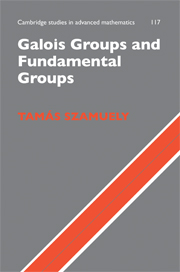6 - Tannakian fundamental groups
Published online by Cambridge University Press: 05 August 2012
Summary
The theory of the last chapter established an equivalence between the category of finite étale covers of a connected scheme and the category of finite continuous permutation representations of its algebraic fundamental group. We shall now study a linearization of this concept, also due to Grothendieck and developed in detail by Saavedra [81] and Deligne [14]. The origin is a classical theorem from the theory of topological groups due to Tannaka and Krein: they showed that one may recover a compact topological group from the category of its continuous unitary representations. In Grothendieck's algebraic context the group is a linear algebraic group, or more generally an affine group scheme, and one studies the category of its finite dimensional representations. The key features that enable one to reconstitute the group are the tensor structure on this category and the forgetful functor that sends a representation to its underlying vector space. Having abstracted the conditions imposed on the category of representations, one gets a theorem stating that a category with certain additional structure is equivalent to the category of finite dimensional representations of an affine group scheme. This can be applied in several interesting situations. We shall discuss in some detail the theory of differential Galois groups, and also Nori's fundamental group scheme that creates a link between the algebraic fundamental group and Tannakian theory.
We only treat so-called neutral Tannakian categories, but the reader familiar with Grothendieck's descent theory will have no particular difficulty afterwards in studying the general theory of [14]. Non-commutative generalizations have also been developed in connection with quantum groups; as samples of a vast literature we refer to the books of Chari–Pressley [9] and Majid [55].
Information
- Type
- Chapter
- Information
- Galois Groups and Fundamental Groups , pp. 206 - 260Publisher: Cambridge University PressPrint publication year: 2009
